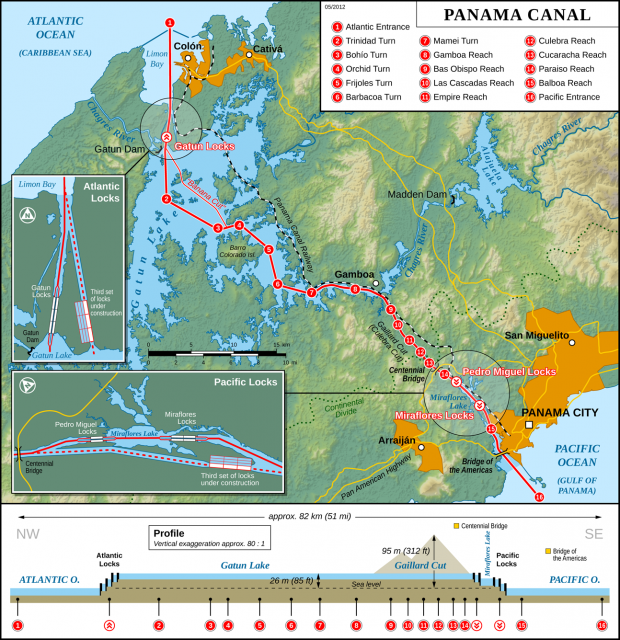Panama Canal
A CANAL THAT LINKS the ATLANTIC and PACIFIC oceans through the isthmus of PANAMA from northwest to southeast, the Panama Canal is 51 mi (82 km) long. A trip through the canal takes approximately eight hours. The Panama Canal consists of a system of six locks that help ships negotiate the water levels of the canal. On the Atlantic side are the three locks at Gatun, and on the Pacific side are a lock at Pedro Miguel and two locks at Miraflores. The locks are in six pairs so that ships can travel in opposite directions. The locks are 1,000 ft (300 m) long and 110 ft (33 m) wide. The Panama Canal was formerly part of the Canal Zone, a 10-mi (16-km) strip of land that was under the jurisdiction of the UNITED STATES from 1903 until 1999.
The desire to find a shortcut from the Atlantic to the Pacific stretches back to at least 500 years ago. The reality of construction on a canal began in 1880 when Ferdinand de Lesseps, who oversaw construction of the Suez Canal, gained a concession from the Colombian government, which ruled Panama, to begin work on the canal. However, after eight years, de Lesseps's plan ended in disaster as a result of poor planning, disease, and political upheavals. In 1889, de Lesseps's company declared bankruptcy and operations were turned over to the New Panama Canal Company in 1894. The same problems of disease and worker unrest also plagued the new owners, and after 1898, the New Panama Canal Company sought out potential buyers to take over construction.

The United States had been interested in constructing an isthmian canal since the early 19th century. In 1850, representatives from the United States and Great Britain signed the Clayton-Bulwer Treaty, which stated that neither the country would have sole ownership or defense of any future canal through Panama. By the end of the 19th century, the United States began its imperial expansion. The Clayton-Bulwer Treaty was replaced by the Hay-Pauncefote Treaty in 1901, giving the United States the sole monopoly on an isthmian canal and smoothing relations with Britain. In 1902, the United States began negotiations with COLOMBIA over the purchasing of the rights from the New Panama Canal Company to build the canal.
The Colombian government, however, rejected the Hay-Herran Treaty because it would lose money in the long term. On November 3, 1903, a revolt erupted in Panama, and it declared its independence from Colombia, with American support. Thus, the United States was in a better position to negotiate for a canal treaty. Under the Hay-Bunau-Varilla Treaty, signed on November 18, 1903, the United States gained the Canal Zone and sole administration and defense of the canal “in perpetuity.”
BUILDING THE CANAL
The building of the Panama Canal is considered one of the great engineering feats of history. Construction began in 1904 under the Army Corps of Engineers led by George W. Goethals. In order to compensate for the varied terrain and the unnavigability of Panama's rivers, the Chagres River was dammed, creating a human-made lake 85 ft (278 m) above sea level, later named Lake Gatun. Ships entering from the Atlantic would enter the Gatun Locks to get to the lake. The Gaillard Cut was then constructed for the sharp descent to the Pacific. The number of laborers it took to build the canal totaled some 17,000, mostly from the Caribbean. Another obstacle to overcome was eradicating disease, which was the undoing of previous attempts to build the canal. Under William C. Gorgas, the U.S. Army eradicated diseases such as yellow fever and malaria by destroying nesting areas of mosquitoes. The project cost $380 million and lasted about 10 years. The Panama Canal opened in August 1914.
The people of Panama were never satisfied with their relationship with the United States regarding the Panama Canal. After negotiations during the 1960s and 1970s, a new treaty replaced the Hay-Bunau-Varilla Treaty, whereby the United States would gradually hand over control of the canal to Panama. In 2000, Panama gained full control over the canal. Issues from the American control of the canal remain, however, such as the cleanup of the ecological damage in the Canal Zone and unexploded ordnance from former test sites.
The Panama Canal contributes about 7 percent to Panama's gross domestic product. In 2001, revenues from the canal came to $215.2 million from annuities, tolls, dividends, and aid from the United States. The majority of the traffic that goes through the canal is from East Asia to the eastern United States. The countries that use the canal heavily are the United States, JAPAN, CHINA, CHILE, South KOREA, and PERU. During the 2002–03 fiscal year, 11,725 oceangoing vessels transited through the Panama Canal. Use of the canal has been declining in recent years because of the everincreasing size of ships being constructed that cannot fit into the locks. To solve this problem, the government of Panama has begun work on widening the Culebra Cut and deepening the Gatun Lake channel and is considering building a third set of locks.